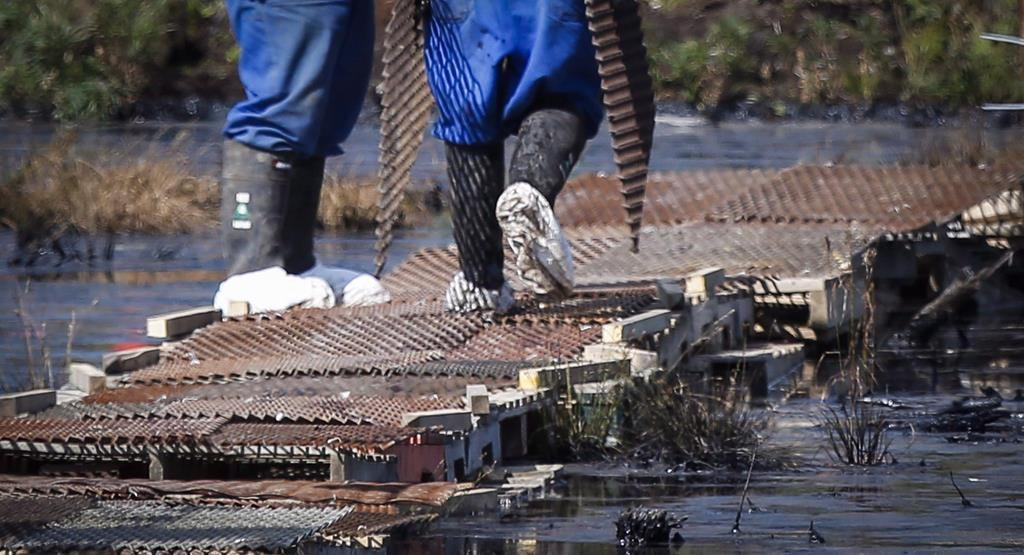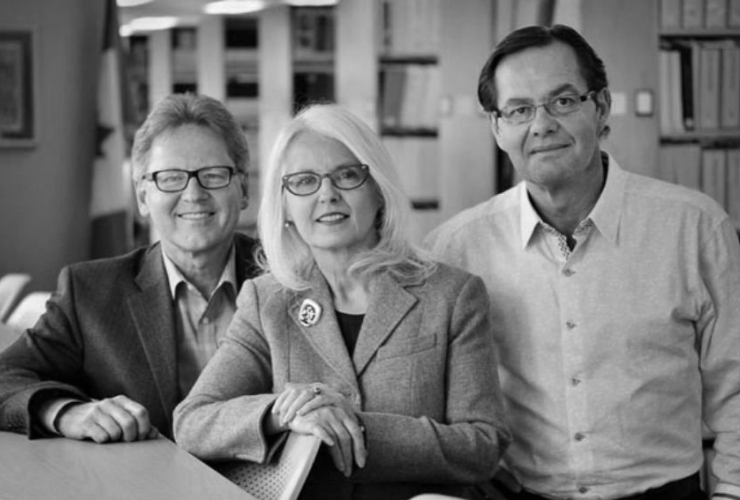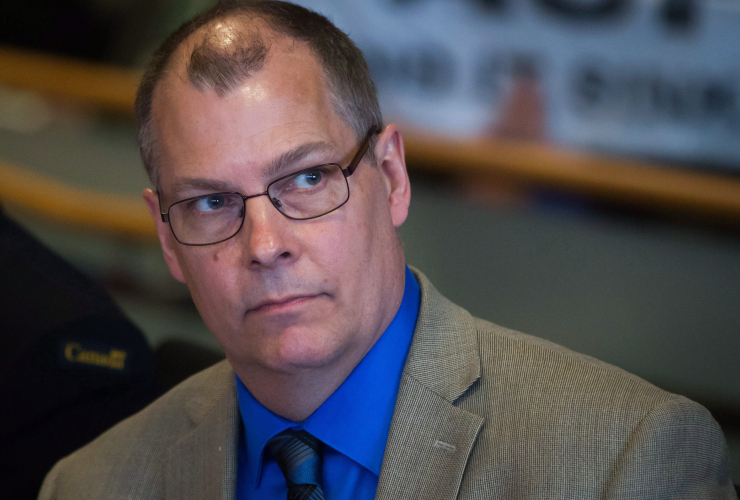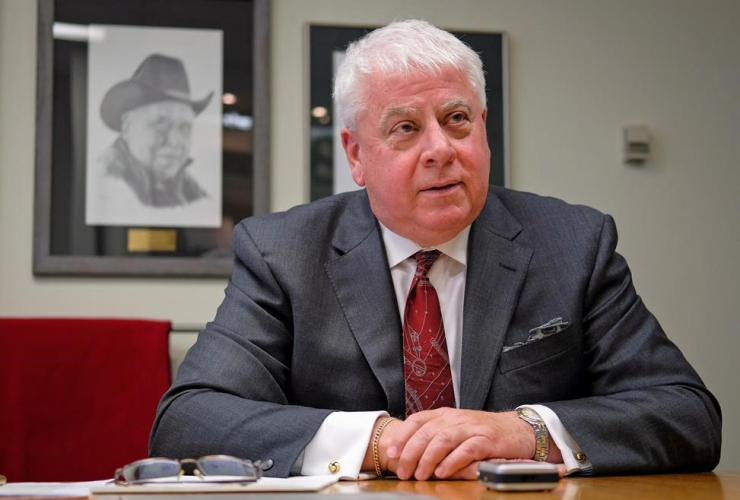Human error — whether it's burying a pipeline too shallow or not fastening bolts tight enough— is increasingly a factor contributing to pipeline leaks, federal data suggests.
Figures compiled by the National Energy Board show that in the past three years, incorrect operation — which covers everything from failing to follow procedures to using equipment improperly — has caused an average of 20 leaks per year. That's up from an average of four annually in the previous six years.
"It's both probably one of the most difficult things for an organization to deal with, but also the most important," said Mark Fleming, a professor of safety culture at Saint Mary's University in Halifax.
Fleming said operators have made improvements in safety practices, but to achieve the higher levels of safety required by other industries such as the airline or nuclear power sectors would require extreme attention to detail.
What may seem inconsequential at first can later contribute to a disaster, Fleming said.
"It's like a ball balancing on the top of a pyramid," he said.
"Safety, particularly very high levels of safety, requires constant attention and effort. And the tendency is for it to degrade."
Pipelines installed in the U.S. in the past five years have the highest rate of failure of any built since the 1920s, and human error is partially to blame, said Carl Weimer, executive director of the Washington-based Pipeline Safety Trust.
"A lot of new pipelines being put in the ground just aren't being installed right, or things don't get tightened up quite enough, so within the first year or two things fail," said Weimer.
The consequences of the improper management of pipelines have come to bear in several spills in recent years, resulting in oil coursing down rivers, gushing onto city streets and contaminating many hectares of Canadian wilderness.
Alberta Energy Regulator investigations into Plains Midstream Canada, for one, found that the company hadn't inspected its pipelines frequently or thoroughly enough, did a poor job of managing the ground around its pipelines and hadn't properly trained control room staff.
A subsequent audit found the company had improved its safety practices, but not before those failures helped contribute to a 4.5-million litre oil spill in 2011 near Peace River, followed by a 463,000-litre oil leak into the Red Deer River a year later.
In 2015, a Nexen Energy pipeline south of Fort McMurray, Alta. burst, spilling about five million litres of emulsion including about 1.65 million litres of oil near its Long Lake oilsands operation. The AER's investigation into the incident continues, but Nexen's preliminary conclusion was that the pipeline design was incompatible with the ground conditions, and wasn't installed properly.
"There's been a lot of learnings in our industry that have resulted from some very unfortunate incidents," said Patrick Smyth, vice-president of safety and engineering at the Canadian Energy Pipeline Association.
Smyth said CEPA, which represents pipeline companies like TransCanada and Plains Midstream, have improved their safety practices in recent years.
He points to the fact that CEPA members spilled only about 2,500 litres of oil in 2015, with companies implementing stricter safety practices and using better inspection tools to prevent leaks.
But even as companies make improvements on safety, Fleming said getting pipelines towards the higher safety standards of industries like airlines will likely require significant financial sacrifice.
"To be able to do that, you need to have a very cautious approach to doing work, and that's something that's hard financially," said Fleming. "It does have some cost implications that we are often very uncomfortable talking about."
"He [Smyth] points to the
"He [Smyth] points to the fact that CEPA members spilled only about 2,500 litres of oil in 2015, with companies implementing stricter safety practices and using better inspection tools to prevent leaks."
Why would Smyth fail to mention the major natural gas releases by CEPA members, totalling 121.3 million cubic feet released, or the 4000 litre methanol release in Alberta by Pembina, all in 2015?
Stricter safety practices proved ineffective for 2016 when Pembina, managed to double the 2015 crude oil release, with just one incident, a 5000 litre release in Alberta, on December 20th.
Industry lobbyists are uncomfortable with discussing the costs of operating safely-which they know are the root cause of most incidents, lack of proper maintenance and inspections- because industry would rather sacrifice public and environmental safety than spend extra capital on increased safety measures. The implications are obvious and evident, more incidents.
To further, regulators are just as guilty of enabling incidents as operators.
Captured regulators fail to properly review applications; the AER claims most of their submissions are taken "on faith" as there are simply too many to properly review each one. The NEB has this problem as well, when they went to review numerous applications, several were critically deficient, particularly in emergency response planning.
Regulators lack proper inspections; the AER has over 1200 employees, only 70 of them are inspectors, tasked with hundreds of thousands of wells sites, facilities and pipelines. Even worse than a non-existent inspection, is an intentionally negligent one. An AER inspector from Red Deer did an inspection on a sour crude oil well near our home, relating to sour gas odour concerns, noise and site contamination. In the presence of the venting production tanks, the inspector documented "no venting on site", because the well site was in a state of temporary suspension-for the duration of the inspection. Additionally, the AER inspector failed to notice or report the well site was operating above the licensed concentration of H2S, and that public notifications for the site were falsified, all information that was documented within AER well site licensing and application files and available to the inspector.
Regulators lack enforcement, in the well sites by our home, I have discovered dozens of non-compliances, the AER refused to levy most of the violations, instead the regulator forced the closure of our complaint files to end all further investigations into these matters. This has happened to thousands of people across our province, where the AER uses totalitarian powers to terminate concerns or complaints, without mitigation or remedy. The AER has no public interest mandate, and no duty of care to the public, if you happen to be impacted by industry violations, you will swiftly come to find, there is no enforcement of mandated directives or regulations.
Regulators work tirelessly to de-regulate. Despite industry pundits and lobbyists proclaiming that Canada has the best regulations in the world, if you actually read the regulations, you will be alarmed at how there is little, to no protection for the public or environment, as well as overarching legislation where regulators are legally immune from any and all of their actions or inactions.
I will use the AER as an example again, within Directive 60, recent changes, permitted off lease emissions, based on the "opinion" of an inspector and the duration, frequency, strength and proximity of the "odours." The AER can not even use the appropriate term for industrial emissions, instead categorizing these hazardous pollutants as "odours" and ensuring no directive exist to protect residents from such harmful pollution. Modelling (not testing, as in reality, operators rarely test air quality during well operations) for sour gas well emissions went from 1% to 5%, which is 50,000ppm-H2S is fatal at 1000ppm.
If you live in an area predominant with sour products, what comfort do you get from knowing the only thing the AER is doing to protect your life, is suggesting operators plug in numbers to an excel spreadsheet, that they may never review or inspect, with values, that if there was an event (Alberta averages two incidents per day), would most certainly cause imminent death? Add this to the fact, that "fail-safe", leak detection is most certainly a fallacy and it becomes a constant worry to live by these dangerous sites. In over 4 years of requests, the AER refuses to provide us with the proper records that any of the sour gas lines surrounding our home have been properly maintained or inspected, based on their immunity under REDA, if these lines do rupture, explode or otherwise harm us or the community, the AER is indemnified, by legislation, they wrote for themselves. The AER does not have to fret, they are protected, the public are not.
Currently, the AER is reviewing offering operators "relief" for the mandated yearly inspections for external corrosion (a significant cause of line failure) under the Pipeline Act. Such de-regulation in light of federal and provincial pipeline audits that demonstrate maintenance, testing and inspection failures leading to incidents, is unfathomable to most, but faultlessly ordinary for the AER. When you have a regulator that is 100% funded by industry, with no mandate to protect the public, you get regulations, directives, inspections and enforcements that shield industry.
Finally, there is another element to pipeline safety, the professional conduct and skill of engineers and geo-scientists, which are governed by self-regulated organizations that are as captured as energy regulators, i.e APEGA. When there is no ethical system for enforcement, investigation and discipline of engineers and geoscientists, that will intentionally look the other way or immorally approve a pipeline or facility, that was installed with substandard materials or in non-compliant conditions, the end result will generally be failure. Until there is an overhaul of all regulatory systems, including those that govern engineers and geos, Canadians can expect the incidents to continue. There will never be "zero incidents" as industry (CEPA) touts, that claim is as imaginary as "fail-safe" leak detection.
Canadians must question if they want these facilities and operations near their homes, schools, hospitals, businesses, water sources and land, with the knowledge there is no duty of care or answerability, on any level. When no-one is accountable, no-one is accountable.
Thank you for this thorough
Thank you for this thorough accounting of what 'human error' looks like on the ground. I think many Albertans would be seriously shocked and outraged if they knew how many of their rural fellow citizens were living under these conditions...........and the impunity with which the industry operates, and the success they have had in keeping everyone silent....is criminal in my opinion.
I have seen your informative posts before and do wish the National Observer would consider inviting you to write an article. We need more truth from the actual earth; less abstract spin from the stratosphere of Big Oil execs.
Thanks ignamarie! Sadly, this
Thanks ignamarie! Sadly, this is but a fraction of the human error we have encountered in the past decade, to think of the many decades of operations in Alberta, coupled with the legacy of impunity and culture of intimidation (I would agree it is criminal, as we have experienced it first hand), the impacts are staggering. The province will never recover, environmentally, fiscally or socially.
Did you happen to see the GoA announcement this morning, touting the new incentive programs of the Modernized Royalty Review? One program, the Enhanced Hydrocarbon Recovery, is most disturbing:
"The Enhanced Hydrocarbon Recovery Program consists of two main components. The first component targets tertiary recovery schemes which enhance recovery of hydrocarbons from an oil or gas pool by miscible flooding, immiscible flooding, solvent flooding, chemical flooding or other methods approved by the Minister.
The second component targets secondary recovery schemes which enhance recovery of hydrocarbons from an oil or gas pool by water flooding, gas cycling, gas flooding, polymer flooding or other methods approved by the Minister.
Under both components of the program, a company will pay a flat royalty of 5 per cent on crude oil, natural gas and natural gas liquids produced from wells in an approved scheme for a limited benefit period."
Taxpayers money, used to subsidize chemical or water flooding of marginal plays to maybe enhance recovery.
The other program uses public money for high cost, high risk, "emerging" plays. This too, is offensive and poor fiscal management, throwing billions of dollars of subsidies at a high cost, high risk, low productivity and low efficiency industry, that imparts billions more dollars of impacts to public health and environmental sustainability, to which all costs are also a burden of the public. Disgusting, nearly, if not absolutely, malfeasance.
http://www.energy.alberta.ca/About_Us/4232.asp
http://www.energy.alberta.ca/About_Us/4233.asp
The editors of National Observer have kindly offered me the opportunity to write for the publication, but the conditions were far from ideal, limiting the content I could cover and without any compensation. Commenting suits me a bit better, I can discuss what I like, there are no editorial interferences, alterations or publication timelines and I am working for free anyway;)
All the best.
The complicity of Alberta’s
The complicity of Alberta’s Oil & Gas Regulator’s is alarming and criminal. Your description is that they are more of a Industry Coddle Shop, they must have sleep issues that they mask with… Diana there are Journal article’s outlining the fact that once a person is impacted by larger doses of H2s, the individual can become impaired at much lower levels. Your problem is that your are susceptible to exposures 24 hours per day living adjacent to a sour gas facility, meanwhile the workers go home after a shift. Nighttime humidity is well known to lower the vagabond gas plumes to ground level. On sunny days the gases disperse more readily, with help from the wind.
Ref: [ Ahlborg 1951, cited in the ATSDR report on Hydrogen Sulphide, 2006 ] Even at lower levels has been reported to produce symptoms. Workers in the Shale Industry exposed to daily levels of hydrogen sulphide approaching 20 ppm experienced fatigue, loss of appetite, headache, irritability, poor memory and dizziness. The fatigue increased both with the level of exposure and with the length of [ your family is captive 24 hours a day ] employment.
[ Beauchamp 1984 ] Three of 10 asthmatic volunteers complained of headache after controlled exposure to 2 ppm hydrogen sulphide for 30 minutes. [ Jappinen 1990, cited in the ATSDR report on hydrogen sulphide, 2006 ], suggesting that symptoms may result from low levels of exposure and that there is some individual sensitivity to the effects of hydrogen sulphide.
People in communities [ 24 hrs/day ] exposed to even lower levels of hydrogen sulphide may experience more neurological complaints than do non-exposed ‘reference’ communities. Excess complaints referable to the nervous system in some exposed communities have included, XXXX [ Legator 2001 ].
Reiffenstein et al reviewed the mechanism of toxicity of hydrogen sulphide [ Reiffenstein 1992 ]. Hydrogen sulphide is lipid soluble and easily penetrates biological membranes. The chief toxic effect is disruption of the cytochrome oxidase and other enzymes involved with oxidative phosphorylation. [ Oxidative phosphorylation is the enzymatic pathway through which we burn foods and capture the resulting energy to support cellular functions, indeed life. Hydrogen sulphide has a toxic action similar to cyanide exposure, and poisons this pathway. ] Carbon monoxide also interferes with the ability to transport oxygen, also specifically inhibits cytochrome oxidase [ Alonso 2003 ].
With chronic exposures to Organic Solvents there can be development of neurological symptoms, “chronic toxic encephalopathy”. The mechanism is when breathing in solvents they assimilate into the blood stream in the lungs. They can pass through the Olfactory bulbs, penetrate the Blood Brain Barrier, and within seconds affect the brain, impairing nerve conductivity, and may cause myelin sheath deterioration.
I suffer a Compensable Toxic Fume Injury attributable to overexposure to Carbon monoxide and H2s, plus 70 other solvents and chemicals worthy of Environment Canada’s deeming the daily tonnage of emissions were worthy of monitoring and publishing. I am in shock as to the corruption with those we assume are there to protect us. In our case, the Client Owner’s Shareholder’s benefited in their Quarterly Profits, meanwhile 6 workers deceased in the first year. The tally now is well over a hundred.
I often think of this author’s last statement;
Garossino: Why Kinder Morgan isn’t the hill to fight and die on
By Sandy Garossino in Opinion, Energy, Politics | December 21st 2016. https://www.nationalobserver.com/2016/12/21/opinion/garossino-why-kinder...
That we should “Take a Hit for the Team”. Oop’s that would mean a Pipeline Corporation’s Investment Team, Ouch! A physician of Occupational Disease stated that our Cluster [1000 tradesman], was the biggest Cover-Up in Canadian Labour History. The impact on rural communities in Alberta who are being exposed to these gas releases is truly a game changer. The Provincial Legislature of Alberta should be ashamed of themselves. I view them as nothing more than Corporitist Call Girl’s / Boy’s, peddling human health at the bequest of the Oil Industry. Have you ever yanked chains at the TSB or Rcmp?
Mandate of the TSB:
http://www.tsb.gc.ca/eng/qui-about/mission-mandate.asp
Well, well, well. Human
Well, well, well. Human error is it? As usual, with government info, what's most interesting is what's left out.
And that's not to deny that poor training, penny pinching quick fixes, and inexperienced or over worked operatives aren't part of the mix. But until we factor in the reality that unconventional fossil fuels are NOT THE SAME as conventional fossil fuels....that they are more costly to extract, more difficult to move, and more dangerous to the environment when they inevitably erode badly made or poorly laid pipes....we're doing spin.
Tar is not Oil. Fracked gas liquified for export is not natural gas. We are seriously into mop up operations when it comes to western Canadian fossil fuels.....and those operations are more costly....seriously eroding our precious 'bottom lines.'
So corners do get cut, workers do lack training...foreign temps with language barriers may be more present than the general public knows........but to boil all this down to human error is in the same ballpark as calling tar oil. Let's just pretend that it flows, that it's the same old same old.............and blame the increased spills on those with the least power.
Cold Lake give this BS the lie...........still leaking, over 2 years since the spill was first detected. Tell us why??
I think its because in that deep terrain they can't figure out what part of the submerged pipe the leak is coming from.........and I'm suspecting they can't shut if off either. So tar boils and bubbles up to destroy unknown hectares of boreal forest.
HUMAN ERROR? or Human hubris? I know which I'm putting my money on.
The Cold Lake Primrose events
The Cold Lake Primrose events were first detected in 2009, the major flow to surface events were reported in 2013 and yes, they are still flowing and will never be repaired.
The final investigation report by the AER confirmed that excessive steaming by CNRL, damaged the cap rock of the formation, allowing bitumen to seep through natural and induced fractures to the surface. Although certain well bores were obvious conduits for seepage, the fissures caused by massive upheaval of steam fracturing the formation are the more prevalent areas, where bitumen is flowing to surface, and these fissures will never be remediated. There is no valve to shut off on multiple fractures of a geologic formation and the AER has permitted continued steaming of the Primrose formation. Error and hubris, the worst combination.
"In its investigation report, the AER concludes that the FTS events were caused by excessive steam pressures, along with open conduits such as well bores, natural fractures and faults, and hydraulically induced fractures."
How can we trust the
How can we trust the companies to run safe operations when they're obliged to place the highest priority on the bottom line? "Capitalism is the astounding belief that the most wickedest of men will do the most wickedest of things for the greatest good of everyone.", said John Maynard Keynes.





Comments